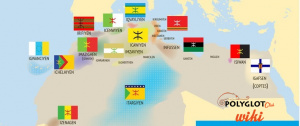Difference between revisions of "Language/Kabyle/Culture/Traditional-dance"
m (Quick edit) |
m (Quick edit) |
||
| Line 1: | Line 1: | ||
<span pgnav> | |||
{| class="wikitable pg_template_nav" | |||
|[[Language/Kabyle/Culture/Traditional-music|◀️ Traditional music — Previous Lesson]] | |||
|} | |||
</span> | |||
{{Kabyle-Page-Top}} | {{Kabyle-Page-Top}} | ||
| Line 91: | Line 97: | ||
{{Kabyle-Page-Bottom}} | {{Kabyle-Page-Bottom}} | ||
<span links></span> | <span links></span> | ||
<span pgnav> | |||
{| class="wikitable pg_template_nav" | |||
|[[Language/Kabyle/Culture/Traditional-music|◀️ Traditional music — Previous Lesson]] | |||
|} | |||
</span> | |||
Revision as of 22:18, 2 April 2023
| ◀️ Traditional music — Previous Lesson |
Kabyle traditional dance is an integral part of Kabyle culture. Like every other dance form, Kabyle traditional dance is a form of self-expression, and it has been used to tell stories, celebrate festivals, and communicate joy and sorrow. The dance is characterised by lively rhythmic footwork, changed-up rhythms, and intricate hand and body movements. In this lesson, we will learn about traditional Kabyle dance and its significance, as well as delve into various Kabyle dance styles.
Consider broadening your understanding by checking out these related lessons: Holidays and celebrations & Berber dialects.
Significance of Kabyle traditional dance
Kabyle traditional dance is an art form filled with ritualistic significance. It is a symbol of the Kabyle culture and lifestyle, and people have danced this way for generations. Dance is a means to express social events, to tell stories about Kabyle life, and to celebrate festivals.
Dance also highlights the spiritual aspect of Kabyle culture:
- Dance is believed to connect people with their past and their ancestors.
- It is also believed that dance is a way to obtain the favour of the Gods and Goddesses.
Dance was a part of everyday life, including both peaceful and tumultuous times. Kabyle traditional dance was also a form of resistance during French colonialism, where dancing and singing were used to communicate rebellion messages without detection.
Dance styles
There are several types of Kabyle traditional dance, all with different character and background stories. Below are the most popular Kabyle traditional dance styles:
Assirem dance
Assirem or “dance of chains” is a historically significant dance that was used to protest during the French colonial era. This dance features women holding onto a linked chain and chanting deeply felt lyrics. The lyrics were primarily of freedom and liberty, and the dance's energy is notable for its reverberating passion.
Guellal
Guellal dance is particularly famous in the Kabyle region. This dance requires a group of men to form a circle and move around in a synchronised manner using the bendir as a background rhythm. The bendir is a traditional Kabyle drum that is usually played by several musicians. Additionally, Guellal features colourful, vibrant outfits with long robes for men while women don colourful dresses with shawls.
Azzefoun dance
Azzefoun refers to Kabyle traditional dances performed by mixed-sex groups, representing love, affection and respect for each other. Often performed in open spaces, these dances involve bending forward to make murmurs, to prove the honesty of each other, and the interlocking of arms and hands.
Ahellil
Ahellil, the music of the countryside, played on a lute, consists of poetic singing, reciting prayers, and ritual narration of ancient legends. Ahellil's rhythm is slow and deliberate, putting its primary focus on the poetic pouring of its lyrics rather than its dance performances.
Conclusion
Kabyle traditional dance is a unique form of artistic expression that has served both as entertainment and as a form of rebellion. It is characterised by rhythmic footwork, intricate arm, and body movements, and tells different stories through different styles. The dance styles mentioned in this lesson are only a small portion of the dances circulated in Kabyle culture.
The significance of the dance and its various styles have contributed to the formation of the cultural identity of the Kabyles that continues to be shared and treasured. By learning about Kabyle dance styles, one gains an understanding of Kabyle culture and gets in touch with the passionate and rhythmic nature of the Kabyle people.
Well done on mastering this lesson! Don't miss these related pages to expand your knowledge: Traditional clothing & Traditional music.
Videos
Algerian traditional dance kabyle - YouTube
Dance traditionnel KAbyle - YouTube
Dance traditionnel Kabyle avec ballet - YouTube
Other Lessons
Sources
- KABYLE DANCE BY TAFSUT IMAZIGHEN AT YENNAYER 2970 ...
- Amazigh (kabyle) traditional Dance | Traditional outfits, Algerian ...
| ◀️ Traditional music — Previous Lesson |
